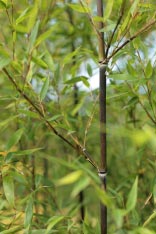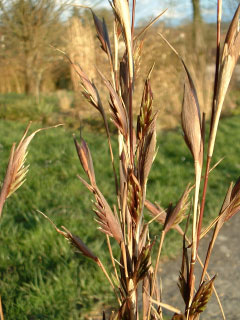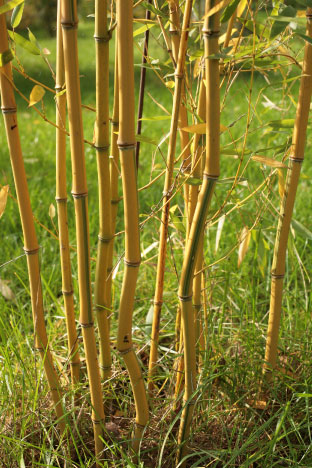A bit of bamboo
They say that the word bamboo comes from the plant’s propensity to explode when the stalks are burnt. It was Carl von LinnéCarl von Linné: Carl von Linné (1707-1778); célèbre naturaliste suédois, père de la nomenclature dite "binominale" (genre + espèce), employée de nos jours pour le régne végétal, mais également pour le règne animal. himself who decided to call this extraordinary plant a "bambu" in Swedish, because of it’s exploding stalks – bang - bomb – bamboo.…

A bit of botany .
Bamboos are above all monocotyledons, belonging to the Poa genus (grasses) regrouped in a subgenus, Bambusa. There are about sixty in the genus, and over a thousand different species.The main characteristic is their stalks formed of linear hollow straws, of very rapid growth. The height of these plants can be anything from 50 centimetres to up to 30 metres in their native land. They are evergreen and grow rhizomes under ground from the main root. These may or may not be creepers, according to the various species.
Their hardiness means that they can endure temperatures of down to -25°c. They need a soil that is cool, well drained and relatively acid. Nevertheless they are often able to adjust to any type of soil, except for marshy land, for most bamboos cannot cope with too much water, that drowns their rhizomes.
Classifying bamboos is a headache – it changes all the time, a state of permanent revolution with numerous synonyms in both genera and species.
We can take as an example a well known bamboo, the Fargesia, of Chinese origin, which has mainly hardy species in France. It exists with two names, usually is the feminine form, Fargesia, and sometimes in the masculine form, Thamnocalamnus . Thus the Fargesia nitidia becomes the Thamnocalamnus nitidus. The Arundunaria have similarly been classified in the Pleioblastus...
Yes, it is complicated business, probably because of the exotic Asian origin of most of the plants, that has not really been assimilated. In fact there are bamboos from other continents – South America or Africa or Oceania, but not a single one from Europe nor for that matter from either of the Poles…
And some of this difficulty comes from the blooming of the bamboo.
A bit about blooming .
An odd thing about bamboos is their flowering, which is rare and a great cause of upheaval for the poor plants. For bamboos do flower, though they are not much good for flower arrangements. Their blooms are delicate spikelets and quite difficult to see (except at the end level!). But above all, when the bamboo begins to flower, it starts to die in the majority of cases.
 This fatal blooming is also at the present state of knowledge impossible to predict. It is a little known cycle, for it can be extremely long, and quite random, happening after up to 80 years, and the most often between 25 and 30 years.
This fatal blooming is also at the present state of knowledge impossible to predict. It is a little known cycle, for it can be extremely long, and quite random, happening after up to 80 years, and the most often between 25 and 30 years.
In this situation, the life of a botanist is not enough to follow through, note down and relate this science of flowering. And since Carl von LinnéCarl von Linné: Carl von Linné (1707-1778); célèbre naturaliste suédois, père de la nomenclature dite "binominale" (genre + espèce), employée de nos jours pour le régne végétal, mais également pour le règne animal., the classification of plants is based on their sexual morphology. What is more, most of the bamboos known in Europe are recent immigrants, recent that is in terms of centuries, which reduces the scope for our struggling scientists.
What is known is that the same species blooms at the same time throughout the world. This is a spectacular occurrence, but normal when you stop to think that bamboos have no seeds, and multiply like clones, by division. The bamboos of any particular species are nearly all brothers, with an identical genetic code, and so wherever in the world they are growing, they will all suffer the same fatal flowering. However, this moment can be affected by climate, soil, and the way the plant was reproduced – bamboos grown with test tube techniques flower earlier.
So finally the flowering of a single species. can last for up to 10 years.
The most recent research does show that flowering need not be fatal in every case, and is different in different species.
What is sure is that the plant puts all its resources into flowering, and because of this it may collapse and die. However for example the lucky owners of Phyllostachys (a hardy genus that is popular in our temperate region) should cut stalks that flower right down to the ground, and dose the plant with fertilizer to compensate for the energy loss. In this case the plant will often recover and as an extra provide new seeds.
It would indeed be prudent to allow for fatal flowering before investing in a bamboo, but no-one is able to predict when this calamity could happen.
People have tried. Take, for example. Phyllostachys pubescens , the largest bamboo growing in France – up to 20 metres high in the region of Nimes.
It was planted in the BambouseraieBambouseraie: depuis peu, ce serait à la fois la dénomination de la bambusaie de Prafrance à Anduze (Gard), mais également un terme générique de plantation de bambous. de Prafrance by its founder, Eugène Mazel in 1856. The flowering cycle was estimated at 70 years. But in the 1930’s it never flowered, and we are still waiting today. So we can now say that the Phyllostachys pubescens has a flowering cycle of over 150 years !
And more about qualities
The motto of the bamboo should be “Citius, Altius, Fortius”, which summarizes its great qualities.
 |
Faster, for a bamboo can grow at a metre a day. Some have sworn that they could se it growing – we have not had such luck, but the turionsTurions: c'est le chaume, cônique, qui sort de terre au printemps et qui, coupé à 30cm de haut, devient la fameuse et délicieuse pousse de bambou. On parle de turion pour désigner également une asperge sortant de terre. of Lorraine Phyllostachys take only 3 weeks to break out of the ground to a height of 4 metres. This is a record in the vegetable kingdom.
Higher, for that is the main aim of a bamboo stalk compared with that of the previous year. The straw grows out of the ground as a cone shaped shoot whose diameter never changes but whose height is impossible to predict. It will stop growing when it is ready and then unfold its branches. In fact the height is always affected by climate and geology.
Stronger – and Further, because the year’s rhizome emerges from the soil more sturdy than that of the previous year. In the case of creeper species, a well fed rhizome can wriggle through loose soil for 10 metres in a season. This can create neighbourhood problems, and the gardener needs to show force to restrain too much exuberance. One can build an anti-rhizome barrier or dig a trench. The other more ecological solution is to borrow a panda, since pandas live on bamboo leaves.
The bamboo has many other qualities. It is as dense as steel, and yet is light and flexible. Its fresh shoots are nutritious, the dry stalks are used as scaffolding, for roofing, for irrigation, as stakes and in dozens of household objects. Industrial uses are multiplying – bamboo parquet flooring is appearing in Europe, and textiles exist that contain 90% bamboo fibres.
In Asia, where most bamboos come from, they symbolise flexibility and also constancy and pugnacity. They are in total harmony with the local population, to whom they offer food, a roof and life saving protection, for the solid network of roots means that a bamboo grove is the best place to shelter during an earthquake.